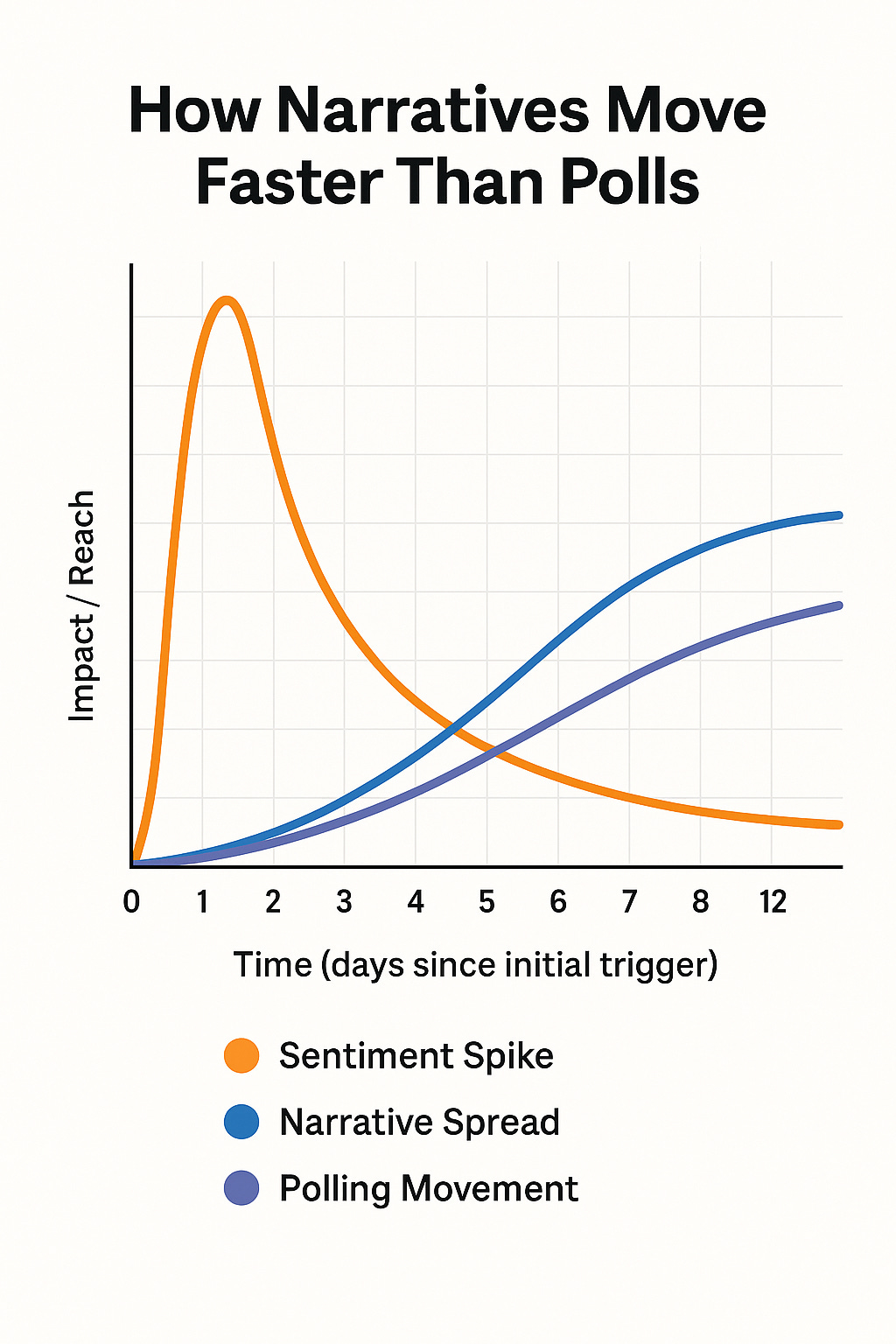The 7 Types, Part 3: Monitoring Sentiment Before the Polls Catch Up
How early sentiment signals reveal what polling and analytics miss.
Most campaigns don’t lose because their message was wrong.
They lose because it was late.
By the time polling catches a shift in the electorate, it’s already priced in. The momentum has passed. The story is set. The moment is gone.
That’s why forward-leaning political teams are no longer just polling or testing messages. They’re watching sentiment signals—real-time indicators of emotion, energy, and attention across different segments of the GOP electorate.
This post breaks down exactly how to track those signals, interpret them through the lens of voter typology, and use them to act faster, persuade smarter, and win earlier.
Why You Can’t Rely on Polls Alone
Let’s be clear:
Polling still matters.
Analytics still matters.
But they aren’t the first signs of change.
Polling tells you what people say they’ll do.
Analytics predicts what they’re likely to do based on past behavior.
Sentiment shows what they’re feeling right now—before they act, before they decide, before they tell you.
That makes sentiment the earliest signal in a winning campaign.
And as political scientist W. Russell Neuman pointed out:
“Emotionally driven signals often precede rational discourse and polling data. By the time conventional tools measure opinion, the emotional driver has already done its work.”
— Neuman et al., Common Knowledge: News and the Construction of Political Meaning (1992)
The Timeline of Persuasion
Here’s how it usually plays out in campaigns:
[Sentiment Moves] → [Narrative Forms] → [Polling Detects] → [Campaign Reacts]But the best teams invert the model:
[Sentiment Moves] → [Campaign Reacts] → [Narrative Forms Around You]The goal isn’t to chase headlines—it’s to detect emotional movement early enough to shape the narrative before it calcifies.
That’s the competitive advantage of sentiment tracking. Not better data. Faster insight.
What to Track (and Why)
Each of the 7 GOP voter types responds to different cues—and you need to know what their emotional activation looks like.
Let’s break it down.
1. The Signal Booster
Your message megaphone.
Watch for: Meme surges, consistent hashtags, rally-level emotion
Signal Type: Amplification, not persuasion
Use it to: Monitor base cohesion—or detect early drift
Warning Sign: When your message loses steam among your own influencers
2. The Narrative Converter
Changes sides when the story shifts.
Watch for: Emotional video shares, reframing language, personal testimonies
Signal Type: Story-driven resonance
Use it to: Time a pivot, reinforce framing, or introduce an emotional bridge
Pro Tip: Look for phrases like “I wasn’t on board until I saw…”
3. The Cultural Contrarian
Allergic to overreach.
Watch for: Sarcastic memes, backlash jokes, influencer ridicule
Signal Type: Rebellion & mockery
Use it to: Spot when your side’s tone or tactics are becoming liabilities
Example: Bud Light backlash began with meme-based sentiment before it became a polling trend
4. The Silent Resistor
Shy but deadly at the ballot box.
Watch for: Whisper networks, local Facebook group chatter, faith-based email chains
Signal Type: Low-volume, high-consistency reactions
Use it to: Detect hidden alignment before a surprise turnout surge
Pro Tip: If something is missing from public discourse but rising privately—watch it closely.
5. The Backlash Parent
Fires up fast over kids, schools, safety.
Watch for: Spikes in keywords like “school,” “my kid,” “they didn’t tell us”
Signal Type: Emotional urgency and threat perception
Use it to: Launch hyper-targeted advocacy before the wave hits broad awareness
Example: The Loudoun County school fight lit up parent sentiment months before Youngkin surged
6. The Reluctant Tribalist
Dislikes both sides—votes for who sounds sane.
Watch for: Comments about tone, reasonableness, “grown-up” behavior
Signal Type: Tone over substance
Use it to: Validate calm, competence-oriented messages
Warning Sign: If your campaign gets sucked into base vitriol, you lose them
7. The Attention Undecided
Doesn’t care—until one issue hits home.
Watch for: Late-cycle Google Trends spikes, topic-specific search interest
Signal Type: Sudden engagement, often issue-specific
Use it to: Drive late-breaking turnout or persuasion pushes on high-salience issues
Example: Crime and gas prices activated this group days before the 2024 Election
The Social Capital Factor
Why do some voter types—like the Silent Resistor or the Backlash Parent—seem invisible until they suddenly flip a race?
It comes down to social capital. As Robert Putnam explained in Bowling Alone:
“High social capital environments—churches, schools, tight-knit communities—accelerate idea diffusion and reinforce norms through trust and conformity.”
— Putnam, 2000 (the Netflix documentary “Join or Die” is worth watching too)
In short: these voters don’t post online—they share through trust networks. Sentiment doesn’t always show up on Twitter. Sometimes it’s hiding in plain sight.
Tools to Monitor Sentiment
Free & Public:
Google Trends (for “Attention Undecided”)
Facebook Groups (Backlash Parents, Silent Resistors)
YouTube Comments (Cultural Contrarians)
X/Truth Social (Signal Boosters)
Advanced:
EyesOver – Track real-time issue sentiment across voter types
Talkwalker – Track velocity of narratives
Text sentiment APIs – Analyze emotional language around your brand/candidate
The Integration Playbook
Here’s how this fits into your campaign system:
You need all three. But if you’re not starting with sentiment, you’re running late.
Final Takeaway
Voter sentiment isn’t noise.
It’s the earliest signal that something is moving.
The campaigns that win in 2026 won’t just be well-funded.
They’ll be early.
They’ll be emotionally intelligent.
And they’ll know which voter types are flinching—before the competition even notices.
Coming Next:
“The Messaging Calendar: How to Talk to Each Voter Type, When It Matters Most.”
Subscribe to get it first—or reach out if you want this system embedded into your race, issue, or organization.



